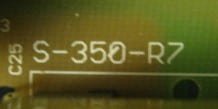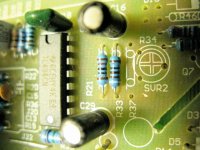Hyena,
Would it be possible for you to scan the trace side? I need you to atleast remove a PCB so we can confirm there are no SMT resistors or components (there may or may not be) as some seem to have trace side components and some don't (but I can't tell by model revision yet).
Using what I know about the few model revisions I have access to, I can take an edumacated guess as to the configuration which you will need to test with a DVM continuity meter or trace by eye to confirm (or post the scan of the trace side).
[Stock Configuration]
R37: 390 ohm, 5% resistor
R21: 10K ohm, 5% resistor
The unit I have worked with the most and now it appears Tailwinds unit as well (thanks for the pics Tailwind, good to get further reference on various models in here) all seem to have the roughly identical componentry and circuits (the guess part) but the TL494CN has a particular connection schematic and so ... between that knowledge and the experience with my own units (with Fechters help!) I can posit a likely workable solution:
Between our models, R21, 33, 37 locations are all within the same rough spacing.... in my PCB R33 is the current adjustment resistor, R37 feeds the unpopulated variable current part of my circuit and to the best i can work out (hopefully fechter with a scope will help sort this out). It seems the other models have a simliar configuration but in your model I think it's just been reversed... so for your unit, R37 is the limiting resistor and R33 would feed the unpopulated component section (still want to figure this part out).
Test this out using a DVM contuniuity meter (beeps when shorted):
R37 (gold most side) should connect to pin #15 on the 494CN
R37 (orange most side) should connect to pin #16 on the 494CN
If you would also take an incircuit reading on the R37 that would be helpful too.
Assuming this is correct(and that your supply is electronically identical with this change at input)... add a second 390ohm in parallel and you should reduce your current by 1/2 the output. This is approx. and assumes no trace side components.
This is a picture of my model with the TL494 section outlined, see the positioning of the R33 and R37 relative to your own. R21 is a high value (as is mine.
Hope this helps!
-Mike









